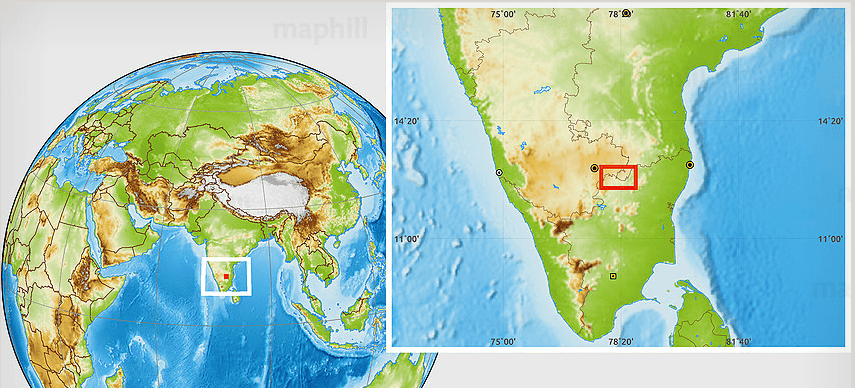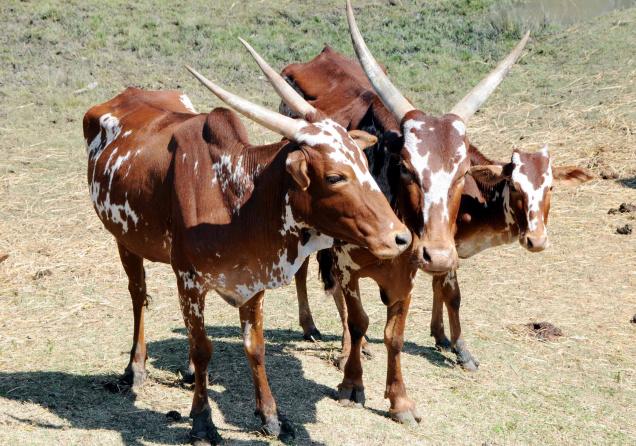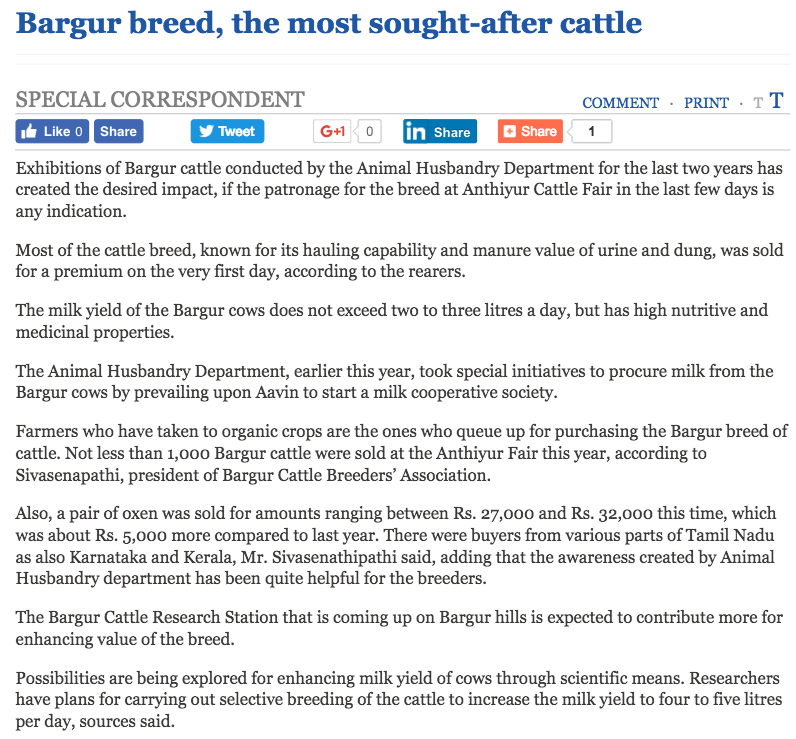Bargur – Cattle Breed (Tamil:பர்கூர்/ Kannada:ಬರಗೂರು)

- Bargur breeds reared mostly in the forest areas of Bargur hills
- Generally, these indigenous breeds are in brown colour with white marking
- These Animals are in Medium Size but well built
- As like most of the indigenous cow, Bargur cow also poor milker
- But it (bullocks) well known for its speed and endurance in trotting in hilly areas
- Due to various reasons, Population of these bread reduced to 10,000
- Historically these breeds are reared by the Lingayaths of Bargur

Origin and History:
The Bargur cattle breed is an indigenous breed of Tamil Nadu, India, that has been reared by the local tribes of the Bargur forest hills in Anthiyur Taluk of Erode District in Western Tamil Nadu in India for centuries. The breed gets its name from the Bargur hills, a mountain range located in the bargur region where it originated. The local tribes, such as the Todas, Kotas, and Badagas, have been rearing the Bargur cattle for their meat and milk for generations.
The Bargur cattle breed has evolved over centuries to adapt to the harsh weather conditions of the region, which includes high altitudes and extreme temperatures. The breed’s adaptation to these conditions has made it resistant to diseases and parasites and has contributed to its popularity among the local farmers.
In recent years, there have been efforts to preserve the genetic diversity of the Bargur cattle breed. The breed was once on the verge of extinction due to crossbreeding with other breeds and the introduction of modern farming practices. However, local farmers and organizations have taken steps to preserve the breed’s genetic characteristics and promote its conservation.
In 2007, the Bargur cattle breed was recognized as a distinct breed by the Indian Council of Agricultural Research (ICAR) and is now listed in the National Bureau of Animal Genetic Resources (NBAGR). These efforts have helped to protect the breed and promote its sustainability for future generations.
Physical characteristics:
The Bargur cattle breed is a small to medium-sized breed with a compact and muscular body. They have a short, glossy coat that is usually black or dark brown, with white patches on the forehead and legs. The breed’s coat color and pattern help to protect them from sunburn and heat stress in the hot and dry climate of the mountain region.
Bargur cattle have small, erect ears and a short, curved horn. The horns are usually black and can grow up to 10-15 cm in length. The breed’s short legs and small stature make them well adapted to the mountainous terrain.
Bargur cattle are also known for their strong and sturdy build, which makes them ideal for carrying heavy loads. They have a docile temperament and are well suited for draught purposes. Their strong, durable hooves help them to navigate rocky and uneven terrain with ease.
Overall, the physical characteristics of the Bargur cattle breed make them well suited to the local environment and the traditional farming practices of the Nilgiris. They are a valuable breed for both their meat and milk production, as well as their ability to work in the fields.
Adaptability:
The Bargur cattle breed is highly adaptable to the harsh weather conditions of the region. The breed has evolved over centuries to thrive in the mountainous terrain, which includes high altitudes and extreme temperatures. The Bargur cattle are resistant to common diseases and parasites, making them a popular choice among local farmers.
The breed’s adaptability can be attributed to a number of factors, including their diet, genetics, and physical characteristics. Bargur cattle are known for their ability to graze on a wide range of vegetation, including coarse grasses, shrubs, and trees. This diverse diet helps them to survive in the sometimes scarce grazing lands.
In addition to their diet, Bargur cattle have unique genetic characteristics that have evolved over centuries of natural selection. These genetic traits help them to withstand extreme temperatures and resist diseases and parasites. The breed’s compact body, short legs, and sturdy hooves also help them to navigate the rugged terrain of the mountain region.
Overall, the adaptability of the Bargur cattle breed has made them a valuable asset to the local farmers of the region. They are able to thrive in a challenging environment, providing both meat and milk for their owners. The breed’s ability to adapt to changing conditions is also an important factor in their conservation and sustainability for future generations.
Milk production:
The Bargur cattle breed is known for its high-quality milk production. While the breed’s milk yield is lower than some other dairy breeds, such as the Holstein or Jersey, the quality of their milk is excellent. Bargur cattle produce milk that is high in fat and protein, making it ideal for making cheese, butter, and other dairy products.
On average, a lactating Bargur cow can produce between 1-2 liters of milk per day. However, some cows may produce up to 3 liters of milk per day during peak lactation. The milk is rich and creamy, with a slightly sweet flavor that is favored by many locals in the mountain region.
Bargur cattle are typically milked by hand, which allows for a more gentle and personalized approach to milking. The milk is usually collected in traditional earthenware pots and transported to nearby markets for sale. In recent years, there has been a growing interest in the unique flavor and quality of Bargur milk, leading to increased demand for the breed’s milk products.
Overall, the Bargur cattle breed’s milk production is a valuable asset to local farmers in the Erode region. Their high-quality milk is a prized commodity, and the breed’s adaptability to the local environment makes them a sustainable and valuable asset for dairy production.
Conservation efforts:
The Bargur cattle breed is considered a rare and endangered breed, with a declining population. In recent years, there has been growing concern about the conservation of the breed, and several efforts have been made to preserve and promote the breed.
One of the most significant conservation efforts for the Bargur cattle breed is the establishment of a conservation center. The center is dedicated to the preservation and promotion of the breed and provides a range of services to local farmers, including breeding services, veterinary care, and training programs.
In addition to the conservation center, there have been several initiatives to increase awareness about the breed and its importance. This includes events such as cattle shows and fairs, where farmers can showcase their Bargur cattle and compete for prizes. There have also been efforts to promote the breed’s milk and meat products, which has helped to increase demand and raise awareness about the breed’s value.
Another important conservation effort for the Bargur cattle breed is the establishment of breeding programs to improve the breed’s genetic diversity and increase its population. These programs are often led by local farmers and conservation organizations and focus on selecting the best breeding stock to ensure the health and viability of the breed.
Overall, the conservation efforts for the Bargur cattle breed are an important step towards preserving this rare and valuable breed. The combination of conservation centers, awareness-raising initiatives, and breeding programs will help to ensure that the breed continues to thrive in the region for generations to come.
Importance of preserving indigenous breeds:
here are some more details on the importance of preserving indigenous breeds, such as the Bargur cattle breed:
- Genetic Diversity: Indigenous breeds have evolved over centuries to adapt to local environments and are often more resilient to diseases and parasites. Preserving indigenous breeds helps maintain genetic diversity, which is crucial for the long-term survival and adaptation of domestic animal populations.
- Cultural Significance: Indigenous breeds often have deep cultural and historical significance to local communities, and preserving them helps maintain a connection to traditional farming practices and local cultural heritage. These breeds often have unique traits, such as specific milk or meat flavors, which are valued by local communities.
- Sustainable Agriculture: Indigenous breeds are often well-adapted to local environmental conditions and require fewer resources, such as feed and medication, compared to imported breeds. This makes them more sustainable and cost-effective for small-scale farmers and can contribute to the overall sustainability of agricultural systems.
- Economic Opportunities: Preserving indigenous breeds can create economic opportunities for local communities. These breeds often have unique products, such as milk or meat, that can be sold at premium prices. Additionally, conservation programs can create jobs and income for farmers, veterinarians, and other related industries.
- Climate Change Adaptation: As climate change continues to impact agriculture, preserving indigenous breeds that are well-adapted to local conditions can help farmers adapt to changing weather patterns and environmental conditions.
Overall, preserving indigenous breeds, such as the Bargur cattle breed, is crucial for maintaining genetic diversity, cultural heritage, and sustainable agriculture. By promoting conservation and supporting local farmers, we can help ensure that these valuable breeds continue to thrive for future generations.

For More Information BARGUR CATTLE RESEARCH STATION
Exhibition of Bargur breed was held in Bargur hills Feb 2014 (Video)
Synonyms: Semmarai, Malayan
Registered breed accession number: INDIA_CATTLE_1800_BARGUR_03003
Country: India
Home or breeding tract: Bargur hills in Bhavani taluk of Erode and Coimbatore districts of Tamil Nadu in India.
Body: Well built, compact and medium in size.
Body colour: Brown colour with white markings. Some white or dark brown animal is also seen.
Head: Long
Forehead: Slightly prominent with a deep furrow between the roots of horns.
Muzzle: Reddish in colour
Horns: loser at root are inclined backwards, outward and upward with a forward curve; sharp at the tip. Medium in size and light brown in colour. Reddish in colour
Tail: With a reddish switch
Hooves: Reddish in colour
Ability as draught purpose: Animals are very sensitive and fiery in disposition and are difficult to train. They are light inbuilt and are developed mainly for carrying out agricultural operations in the uneven and hilly terrain. Cattle of this breed are unsurpassed in speed and endurance in trotting.
Accession number: INDIA_CATTLE_1800_BARGUR_03003
Need Support:
We are currently searching for additional photographs and information on this breed. If you have materials which we could borrow or if you know of a potential source please contact us using the comment form below.
The Imperial Council of Agricultural Research – 1941 (Bargur Breed)
These cattle are breed extensively in the bargur hills in Coimbatore district of the Madras province.
They are of the Mysore type of cattle but are smaller and more compact, and the forehead is not so prominent as in other Mysore breeds. They are very fiery and restive and difficult to train. For the spirit, the power of endurance and speed in trotting they are said to be unsurpassed.
The chief points to note are:- A long well-shaped head tapering towards and upwards, a moderate-size hump, compact body with well-arched ribs, a well-marked but fine dewlap, fairly tight sheath and a rather short tail.
Author F.WARE
Year Published: 1941
How to shoe a Bargur Bull <Video>
Burgoor Cattle breeds of Tamilnadu<Video>
[mlink subhd=”Umblachery Cattle Breed” link=”https://nativebreed.org/blog/category/umblachery/”]Read more about Umblachery [/mlink]
[mlink subhd=”Alambadi Cattle Breed” link=”https://nativebreed.org/blog/alambadi-breed-cattle/”]Read more about Alambadi [/mlink]
[mlink subhd=”Puliakulam Cattle Breed” link=”https://nativebreed.org/blog/puliakulam/”]Read more about Puliakulam [/mlink]
Read More: Other Native cattle
For More information and purchase on different indigenous breeds
Alambadi Cattle | Amrit Mahal Cattle | Bachaur cattle | Bargur Cattle | Gir Breed |Kasaragod Dwarf Cattle | Kherigarh Cattle | Krishna Valley cattle | Malnad Gidda Cattle | Mewati Breed | Ongole breed cattle | Ponwar Breed | Pulikulam Cattle | Umblachery Cattle | Vechur Cattle Breed
Read More: Native Dog breed
For More information on Indian native dog breeds.
Banjara Greyhound | Bully kutta mastiff | Chippiparai Hound | Gaddi Kutta mastiff | Indian Spitz | Jonangi breed | Kanni hound dog | Kombai/Combai hound dog | Mudhol Hound | Pandikona Hound | Rajapalayam Hound | Rampur Hound
Also Read : Other Blog
How to Recognise Native British Cattle Breeds | The American Bison | Recognized indigenous cattle breeds of India | List of Bos Indicus Breeds – Zebu Breed | First Domesticated Cattle in the World : Origin of Modern Cows Traced | 40 million cows to get Aadhaar like number at cost of Rs 50 crore in 1st phase : Budget 2018 | Registration of livestock/poultry breeds rises to 169: Govt | Chennai to host expo of indigenous native cattle breeds on Jan 6 and 7. | Kerala Sets up a special reproduction centre to help grow Vechur cattle population | Andhra pradesh well poised to become a seed hub, says Bill Gates | Using Cow Dung of Indigenous Breeds, This Farmer Makes Lakhs from Organic Papaya | Kampala to host 2017 livestock show | Cargill to plough millions into animal nutrition business in India | Supreme Court issues notice to Tamil Nadu government on PETA plea against jallikattu | Haryana govt plans PGs for cattle to boost milk production | Molecular Characterisation of Rathi and Tharparkar Indigenous Cattle (Bos indicus) | Embryo transfer technology to be used to carry out 440 embryo transfers in cattle in 9 days | ‘Rettamalai Ondikaruppu’ Temple Bull , is no more | Decline in indigenous cow breeds: NGT summons official | Maharashtra moos to boost desi/Indigenous cow varieties | Soon desi cow’s milk will be sold through medical stores: Warns Rajasthan minister | Telangana ties up with Brazil to improve Desi milk production | Project Mooo: supporting India’s dairy farmers with sustainable technology | Government allocates ₹2.5 cr. for protection of native cattle breeds | Project to preserve indigenous cattle – Karnataka.| Alanganallur was the most crowded village today in India! | Tamils Gathered in America, To show Support Jallikattu!! |